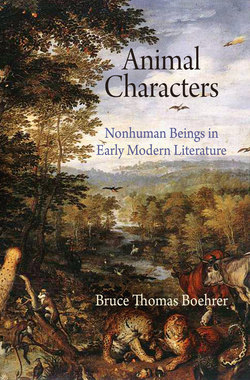Animal Characters

Реклама. ООО «ЛитРес», ИНН: 7719571260.
Оглавление
Bruce Thomas Boehrer. Animal Characters
Отрывок из книги
A volume in the Haney Foundation Series,
established in 1961 with the generous support
.....
The general purpose of these peculiar renderings becomes clearer if we consult the interpretive endnotes appended to each canto of Harington's 1591 translation. At the conclusion to canto 1 (and again after canto 2) the endnote on “Allegorie” fits Baiardo into an emblematic tradition stretching back to Plato whereby Rinaldo's mount, “a strong horse without rider or governour, is likened to the desire of man that runnes furiously after Angelica as it were after pleasure or honor or whatsoever man doth most inordinately affect” (1.Allegorie). Standing here for “mans fervent and furious appetite”—his “unbridled desire” (2.Allegorie)—Baiardo is in manifest need of rational—that is, human—governance, and Harington's local renderings of specific lines from Ariosto help to fit the verse, as it were, to this particular construction. In so inclining Ariosto's poem, Harington integrates it into a popular mode of Platonic allegoresis, grounded originally in the Phaedrus, to which I shall return soon. However, he does so at the cost of Baiardo's own claims to rational motivation, which have led other readers of Ariosto to view “the wise horse” as “a sly pun on ‘Boiardo,’ whom Ariosto is ‘following’ much as Rinaldo pursues his (apparently errant, actually purposeful) steed” (Ascoli 28n52). Harington's translation and glosses open up the former line of interpretation at the same time that they foreclose the latter, and apparently all because Harington was comfortable assigning instinctive motivation to Baiardo's behavior but drew the line (or tried to, at any rate) when it came to endowing the beast with a human mind.
Of course, drawing the line between species was not a concern for Harington alone in the early modern period. As Erica Fudge has observed, the conventional early modern discourse of species difference was riddled with conundrums, exceptions, contradictions, and downright absurdities—a set of “logical breakdowns” that “the reemergence of skepticism” in the late sixteenth and seventeenth centuries, particularly via the philosophy of Descartes, “offers…a way of thinking through” (Fudge, Brutal Reasoning 122). In this broad cultural context, the persistence of animal characters like Baiardo—endowed with the capacity for language, with self-awareness and awareness of others, with the ability to reason in the abstract, with personal and political agency, and with a privileged position in complex social networks that cut across the boundaries of species—emerges as one aspect of a much larger philosophical dilemma. Simply put, horses like Rinaldo's make it impossible to think of humanity as a distinct category with exclusive attributes. Baiardo's legacy puts the question, as it were, to humanism, suggesting on the intuitive level what Giorgio Agamben has asserted more directly: that “the humanist discovery of man is that he lacks himself, the discovery of his irremediable lack of dignitas” (30). Form does not differ from emptiness; emptiness does not differ from form.
.....